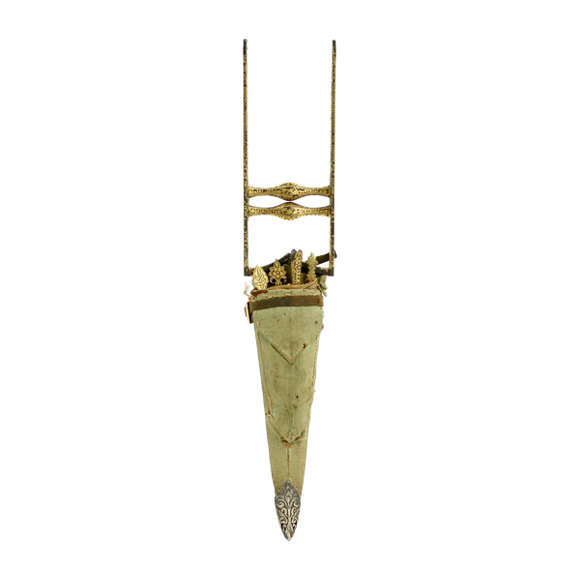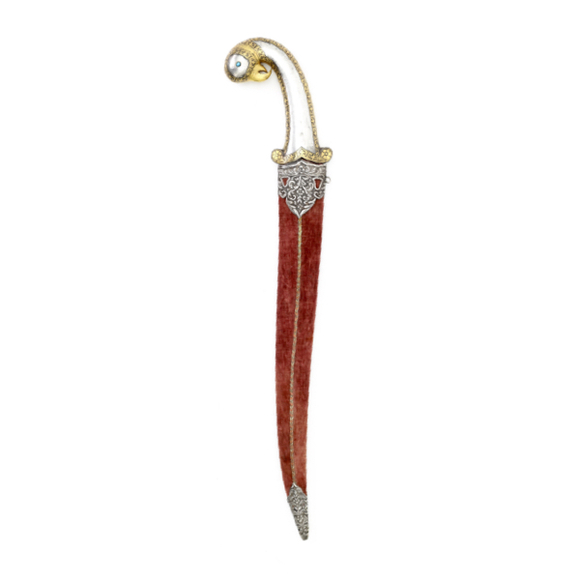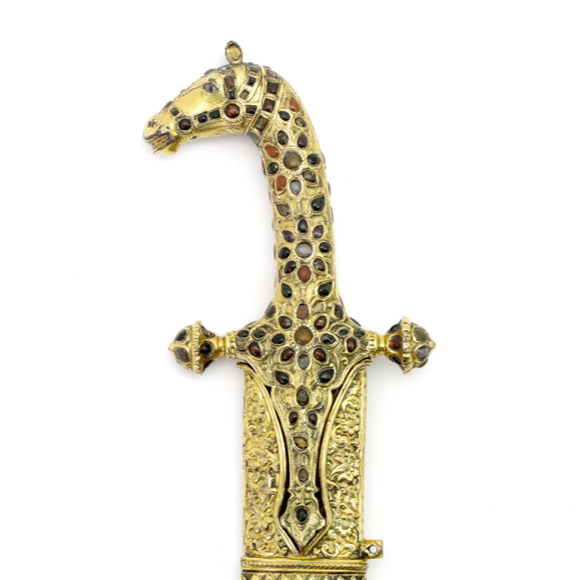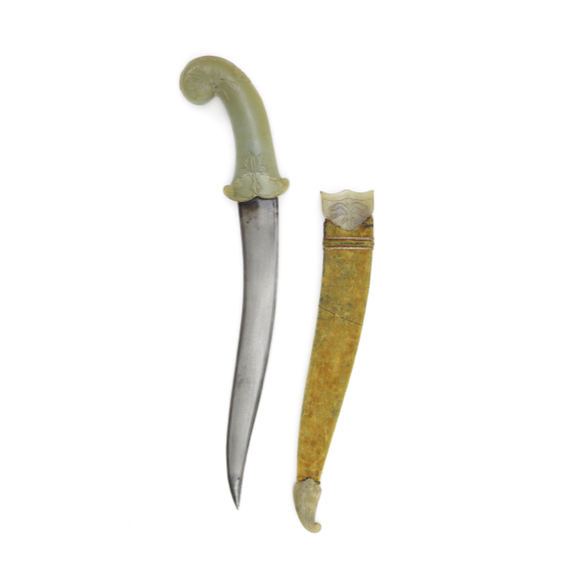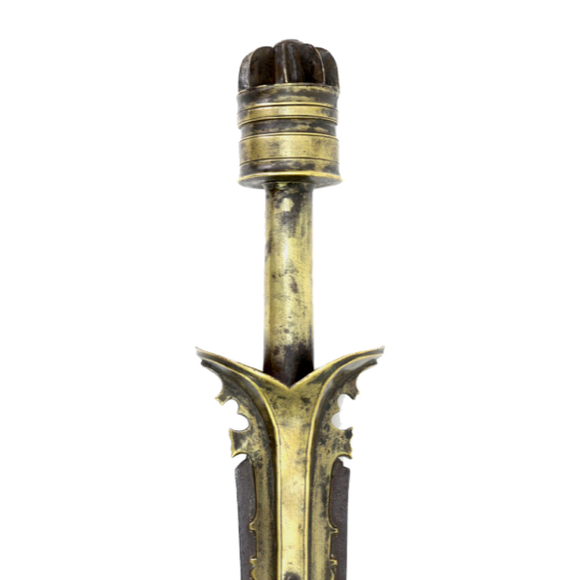With a fine wootz blade with a pronounced center ridge.

83 cm
72.5 cm
forte 6 mm
middle 5 mm
near tip 2 mm
forte 33 mm
middle 24 mm
near tip 17 mm
857 grams
Blade: Central Asia or India.
Hilt: India.
Steel, iron, brass, wood, velvet, gold.
Blade probably 17th century.
Hilt possibly later.
Ex Artzi Yarom collection
Ex Philip Tom collection.
Description
A fine, deeply curved sword blade in the style of Persian shamshir, with an early style moderate curve. It has a wedge-shaped cross section with a healthy "clamshell" edge geometry giving it good weight. Also, in keeping with Persian forms it has no ricasso like the Indian talwar tends to have.
The steel exhibits a tightly forge folded construction creating a fine wood-grain texture like the hada on some Japanese swords. It has a high carbon inserted edge, itself also formed of many fine layers, exposed from the entire edge including the long, sharp backedge. It was tempered to form cloudy effects of martensite structures in the carbon that makes a hard cutting edge, much like that effect in Chinese and Japanese swords. All in all it exhibits many characteristics of Far Eastern (or perhaps Central Asian) techniques. on a blade of Persian form.
The base of the blade on the left side is chiseled in a rare type of decor first seen on early Mamluk swords of the 15th to early 16th centuries, and which was later continued on some Persian and Ottoman swords.

This sword compared to an early Mamluk sword blade in the Topkapı Palace Museum collection.
Inscriptions
The blade carries two inscriptions on the right side, one in a cartouche partly hidden under the langet and another on the upper "tongue" of the chiseled decoration.
The inscription in the cartouche reads:
Ala Allah Tawakkaltoo Khoon
"By My Blood, I Surrender myself to Allah"
The inscription on the elongated feature reads:
La Fata illa Ali la saif illa Zulfiqar
"No warrior but Ali, no sword but Zulfiqar"
The last phrase is frequenly used as a talisman for Muslim warriors. It is a quote from the 10th century Persian classic Tarikh al-Tabari (تاريخ الطبري) or "History of the Prophets and Kings" by Muhammad ibn Jarir al-Tabari (838-923). According to the story, Imam Ali (cousin and son-in-law of Muhammad), broke his sword during the battle of Uhud in 625 A.D. While fighting continued he went to Muhammad to say he couldn't fight anymore, after which Muhammad gave him the sword called Zulfiqar. Ali fiercely continued figthing after which Muhammad proclaimed his famous words, La Fata ella Ali la seif ella Zulfiqar .
ZulfiqarZulfiqar is a legendary sword surrounded by various, often contradicting stories. In the above mentioned Tarikh al-Tabari ("History of the Prophets and Kings"),, written no later than 923 A.D. there is no mention of Zulfiqar's shape, but it was given to Ali by Muhammad during the battle of Uhud in 625 A.D. In Shahnameh ("The Book of Kings"), written between 977-1010A.D., Zulfiqar is a bifurcated sword attributed to mythical Iranian hero Rostam. In Noskhe-ye Haft Darvish ("The Copy of Seven Dervishes"), 1000 A.D., Zulfiqar is depicted as a bifurcated blade. According to Al Atharhul-Bakiya ("The Chronology of Ancient Nations"), 1590-1688 A.D., Zulfiqar was created by God a 1000 years before creation of the world and Adam. God looked at the sword, and upon his gaze the sword split into two, making it bifurcated. Other sources state Muhammad had obtained it from an infidel called Munabbih Ibn al-Hadjdadj, and yet others say it was from a man called Ase Ibn Moniyeh. Sir Richard Francis Burton wrote that Zulfiqar was originally the sword of Archangel Gabriel that was passed down to Muhammad and then to Ali. Alternatively, Zulfiqar can be translated also as "having a spine", "being notched" and it is quite likely that the real Zulfiqar, if it ever existed, was not a bifurcated blade at all. Over the centuries, many versions of Islamic bifurcated swords have been made in honor of Zulfiqar. For further reading, see: |
Hilt & scabbard
The blade is mounted in an Indian hilt of a type often found on Indian talwar, but in some occasions also on (imported) Persian shamshir type blades. It is made entirely of iron, with thick silver overlay, most of it remains intact. It is decorated with floral designs punched into the silver sheet, creating a shallow relief.
The style of hilt, with slightly forward swept quillons, was popular in Lahore which may explain the strong Persian influence on the blade.
It comes in a newly made scabbard, in Indian style, covered with old dark red velvet.
Attribution
This sword is part of a very small group of similar swords with Mamluk style blade decor. I sold one previously with a typical Rajput hilt and markings attributing it to the Ratlam State, located in Madhya Pradesh, central India. A few circulate in antique arms collecting circles, but I currently know of no comparable pieces in museum collections.
Persian influence in arms is prevalent in north India, most notably the Punjab area, but also the Deccan. Deccan rulers had connections to parts of the Middle East since the 15th century. Yusuf Adil Shah, Sultan of Bijapur was a descendant of the Ottoman ruling house and had fled Turkey to the Deccan. Quli Qutb Shah, Sultan of Golconda, originally came from a region dominated by the White Sheep Turkomans who were ethnically related to the Mamluks. Both rulers, along with the Sultan of Ahmedagar, had close ties with Iran's Safavid Dynasty. All brought Persian and Mamluk design influences to the Deccan, which we find on the sword currently under discussion.
Conclusion
A most interesting sword with chiseled decor on the forte that is stylistically of Mamluk origin, paired with a for India unusual forging style. The blade is of very high quality. It carries two Islamic inscriptions, talismanic in nature. It has a later Indian hilt with silver overlay, of a form popular in Lahore. The Mamluk blade decor may either be linked to Persian influence into north India, or Islamic rulers of the Deccan that have Middle Eastern roots.




















The style typical of Kutch, the execution far above what is normally seen on work from that area.
Nice and complete with opaque green hilt and scabbard mounts.
An early fighting piece with strong reinforcing langet and broad, cobra shaped tip.

